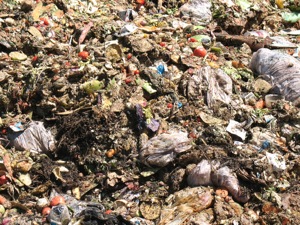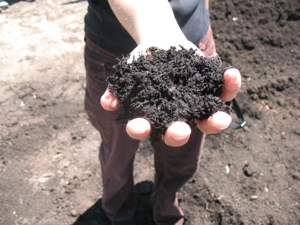Thanks to the resurgence in gardening and food in general, most of us know about compost. Many of us have even taken a shot at a backyard compost bin or even a vermicomposter. Now, Minneapolis is taking composting to the next level--commercial composting. For those of you unfamiliar with the term, perhaps you have seen signs promoting composting at restaurants and farmers markets. The Birchwood Cafe, Mill City Farmers Market, Bryant Lake Bowl, Bread and Pickle, and Anodyne are just some of the folks taking the initiative to compost everything from paper products to food waste.
Even more interesting are the green, curbside compost bins seen in Minneapolis' Linden Hills and Seward neighborhoods. On the side of them is a list of the "acceptable" items, such as: bones and meat, pizza boxes, non-recyclable paper, full vacuum bags, and of course, vegetable and fruit waste. Right away, a curious mind begins to wonder what this is all about. Anyone who has ever had a backyard compost bin knows that when it is time to spread it on the garden, it is inevitably filled with peach pits and paper bits that haven't broken down.
 So, what gives? How in the heck do my pizza boxes turn into wonderfully rich, black compost? These questions are what led me to follow the signs that eventually lead you to Eureka Recycling. These are the folks behind the composting movement at our local Minneapolis restaurants. They know that to get to zero waste, we absolutely must include composting. As a matter of fact, restaurants can easily divert 90-95% of their discards through composting recycling. As for the average Minnesota household...what is left in the trash is usually at least 50% recyclable/compostable.
So, what gives? How in the heck do my pizza boxes turn into wonderfully rich, black compost? These questions are what led me to follow the signs that eventually lead you to Eureka Recycling. These are the folks behind the composting movement at our local Minneapolis restaurants. They know that to get to zero waste, we absolutely must include composting. As a matter of fact, restaurants can easily divert 90-95% of their discards through composting recycling. As for the average Minnesota household...what is left in the trash is usually at least 50% recyclable/compostable.
First, a bit of background about Eureka Recycling. They are a very unique organization. Their mission is to demonstrate that waste is completely preventable. In talking with Lynn Hoffman, Associate Director of Communications at Eureka, I began to understand that the very structure of the company is unconventional. It is a non-profit, but one that knows how to make money where they can. What is comes down to is that they have taken on the recycling business as a business. The income they get from recycling fees pays for the trucks and other overhead that makes the business run. This frees up any grants and donations that they receive for research and pilot projects that are in line with their mission, such as commercial composting.
It is fairly well known how compost works. As in other chemical reactions, you need a certain balance of elements for the reaction to take place properly. For compost, Water, Air, Nitrogen (think greens: grass clippings, food), and Carbon (think browns: dead leaves, paper) are needed in the proper proportions. This is why backyard composters quickly learn that you cannot just pile up a bunch of dead leaves to make compost. You also cannot expect to pile up grass clippings, yard waste and dead leaves and have them magically turn into compost. It might happen, but it will take years and years. You have to stir the pile up allowing air to circulate and there has to be water involved as the "fuel" for all of the enzymes and bacteria that are hard at work breaking down the organic materials.  Hard to believe this will ever be compost
Hard to believe this will ever be compost
The folks who are in charge of composting the food waste collected here in Minneapolis, namely SET (Specialized Environmental Technologies, Inc./The Mulch Store) know all about the proper chemistry and more. They are well aware that this balance must exist, but more importantly, they know how to measure it. Temperature is a key indicator in understanding the "health" of compost and they have the right tools at their disposal. Huge thermometers that they can plunge into the compost allow them to monitor and then adjust temps. Good compost reaches very high temperatures and readings that are off require adding one of the above elements, whether the pile needs nitrogen, carbon, a good stir, or some water.
Then there is the "stirring". Well, fine, Anne Ludvik, my contact at SET informed me it was a bit more involved than that. Imagine how much backyard composters struggle with turning their pile. Now take tons and tons of the messy stuff and try and deal with it. Well, it takes huge machinery and, I imagine, nose plugs. Anne described the proper vehicle as follows:
"Yard waste and Source Separated Compostable Materials (SSCM, a.k.a. food waste mixed with non- recyclable paper) are mixed using a Roto-Mix vertical mixer powered by a 160 HP tractor. The operators add the proper amount of carbon and nitrogen and moisture in the mixer and place this mix on aerated pipes to get the correct amount of oxygen."
I imagine it being sort of like a combine that chews up the pile of compost and spits it out behind it, making a nice new pile of fine, balanced compost. After Anne's description though, I might as well include a crayon drawing with mine.
Now let's consider pizza boxes and meat. High temperature helps not only break these down, but kill off any pathogens that may develop. In a way, compost is like cooking. High heat can not only help sterilize and tenderize, it can turn things to mush. Especially if everything is chopped up nice and fine. With constant monitoring, maximum heat and proper stirring, waste is turned into finished compost in just six months!
The final question for this conversation is: "Why isn't the practice of commercial composting widespread?" As I understand it, the answer is multifaceted. First, Lynn explained to me that so far, there are no separate regulations or laws about the handling of compost. It was until recently legally defined as garbage, and therefore had to be treated as such until there is new legislation, as developed by the Pollution Control Agency of MN. The process has begun, but until everything is settled and in writing, compost has to be handled in a certified landfill site. At SET's composting facility, it is not actually a landfill, but has an impervious clay liner which was made with the same constructions specs as those at a landfill.
While compost has its issues, such as run off, smell and pests, it certainly doesn't require the same containment that current landfill regulations require. This currently makes it very expensive and onerous to start new composting facilities. Therefore, the number of sites in Minnesota are few and this greatly limits the accessibility and affordability for most communities. As a matter of fact, the Twin Cities only has one approved compost facility, that being located in Empire Township (SET). To help address this barrier, Hennepin County has taken action to support local programs by reducing the "tipping fee" at a transfer station in Brooklyn Park. This has encouraged independent haulers to take part in composting, knowing that they won't lose money on the deal by hauling their waste all the way to Empire. However, St. Paul and eastern suburbs still lose out on the deal and are not participating due to prohibitive transportation costs.  The finished product
The finished product
As you can see, commercial composting is beginning to gain traction as a viable option, but there are still hurdles to clear and education to be done. Even people who understand the basics of composting are still confused by the idea of composting anything that isn't food, especially those compostable "plastic" cups and flatware. And what about the word "biodegradable"? If you think that means compostable, you may be mistaken. I think the idea of having to think about our waste at all is something most folks would rather ignore, but the time is now.
It is also the time to realize that this is not the end of our problems, but just the beginning of possible solutions that will get better and better. Using compostable cups made out of a biodegradable corn based polymer is not the answer. First, they take lots of energy and a possible food crop to produce. Second, they only have a small benefit if they end up in compost, which many do not. If they end up in a landfill, there is no way they will break down. By law, modern landfills are designed to by dry and air-tight to prevent the creation of run-off and methane emissions. In the end, we still need to use less, but a sustainable waste system absolutely must include composting. I will present an argument to why compost is safe and important in an upcoming article. Until then, use less, compost and help to educate others about mindfulness and waste.
Buy back your waste at The Mulch Store (run by the above mentioned SET, inc.)
Discover facts about biodegradable products, composting and EPA landfill info at: bpiworld.org.
City of Minneapolis composting guide
Linden Hills Power and Light has a lot of links, video and info about composting.

Lawrence Black is a writer and editor at Simple, Good and Tasty. He can be reached at lawrence@simplegoodandtasty.com.
Photos courtesy of Eureka Recycling and SET, inc.




